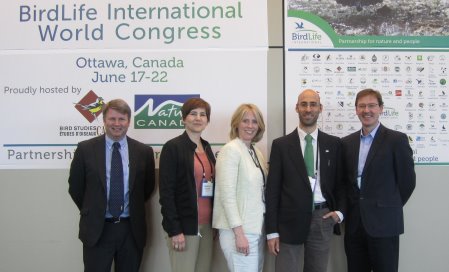
Golf’s governing bodies, The R&A and the USGA, supported by the Golf Environment Organization (GEO) promoted the game’s environmental efforts at one of the world’s largest sustainability conventions, the BirdLife International Congress, held in Ottawa, Canada.
With attendees from conservation and community groups in more than 120 countries, the Congress aimed to demonstrate how human health, wealth and security are directly linked to biodiversity; and to showcase examples of organisations and sectors that are providing solutions for biodiversity conservation and sustainability.
Steve Isaac, Director -Golf Course Management at The R&A expressed his enthusiasm for the event, saying: “We reached out to BirdLife Europe earlier this year with a view to exchanging information on golf and biodiversity, and now we are delighted to be here, sharing and listening, alongside the USGA and GEO.
“The theme of the Congress is ‘Partnerships for Nature and People’. Few land-based sports bring so many people into contact with their local, natural surroundings. With the two global governing bodies of the game working so closely together, it is clear to see what an opportunity golf has to establish itself as a valued contributor to the wider efforts to address very real challenges and concerns that face society and the environment.”
Kimberly Erusha, Managing Director, USGA Green Section, added: “Across the United States, and around the world, many of the 33,000 existing golf courses work hard to provide for communities and nature. Sustainability is becoming more comprehensively integrated into golf course operations.
“We encourage all parts of the industry to embrace ecological richness, resource efficiency and local community – as core components of strong golf businesses, and fundamental to the future reputation and relevance of the game. On a platform of credible programs and bringing forward verified case studies and information from golf courses, we’d also like to see golf take a well earned position as example of and advocate for sustainability in communities around the world.”
During a workshop at maximum capacity with attendees from more than twenty countries, the three organizations set the scene with a big picture perspective of golf on one planet; reinforced with practical examples of the work the industry has undertaken across research, education, guidance, tools, programmes and communications. Club and development case studies demonstrated how industry strategy was connected with on the ground evidence, and a roadmap for the future was outlined and used to prompt open discussion with delegates.
Reflecting on golf’s current contribution, some of the key points raised included:
- Nature – with an average of 50% of every golf course being ‘out of play’, golf’s 33,000 existing golf courses can safeguard considerable greenspace for biodiversity
- Water – probably golf’s greatest technical challenge, with continuing research on turfgrasses, recycling and irrigation needing to be combined with ongoing education of practitioners
- Community – the vast majority of golf courses are community based and provide accessible health, recreation and social interaction for young and elderly alike, supplied by a diverse range of other businesses and sectors, and generating an estimated economic value of more than $150 billion globally per year.
On closing the workshop, GEO Chief Executive Jonathan Smith concluded: “Sustainability is now a central driver of public perception, government policy and business profitability, directly relevant to golf’s future growth and success. It has been tremendously useful to be here to identify what others in mainstream sustainability think the sector is doing well and where there is room for improvement. It helps GEO to help people in golf understand the real issues and opportunities; take effective practical action; and maximize golf’s positive contribution to people and the environment.”
Ariel Brunner, Head of Policy at BirdLife Europe, who was chairing the open discussion stated “The BirdLife World Congress thrives on open, honest and science-based discussions, engaging diverse groups from civil society, government and business.
“The golf industry needs to continue to confront and address negative impacts, particularly to ensure that existing natural habitats are not converted into ecologically poor landscapes.”
He concluded, “Today we have heard about some exciting experiences suggesting a more responsible approach is emerging.”
International Golf Federation Sustainability Policy:
As long standing advocates and supporters of sustainability in golf, the USGA and The R&A played a key role in the production of the International Golf Federation’s Sustainability Policy.
This policy united more than 153 golf organisations in making sustainability a core pillar of the game.
USGA www.usga.org.
The R&A www.RandA.org
Golf Environment Organization (GEO) www.golfenvironment.org

